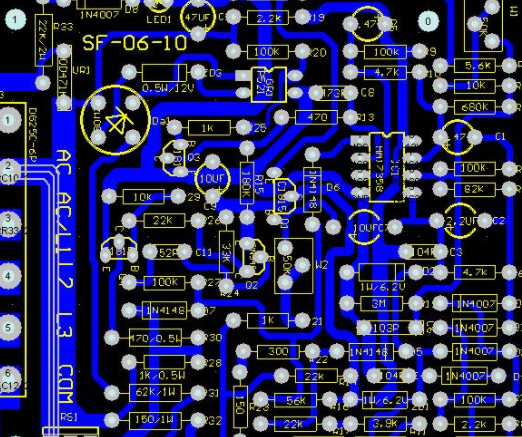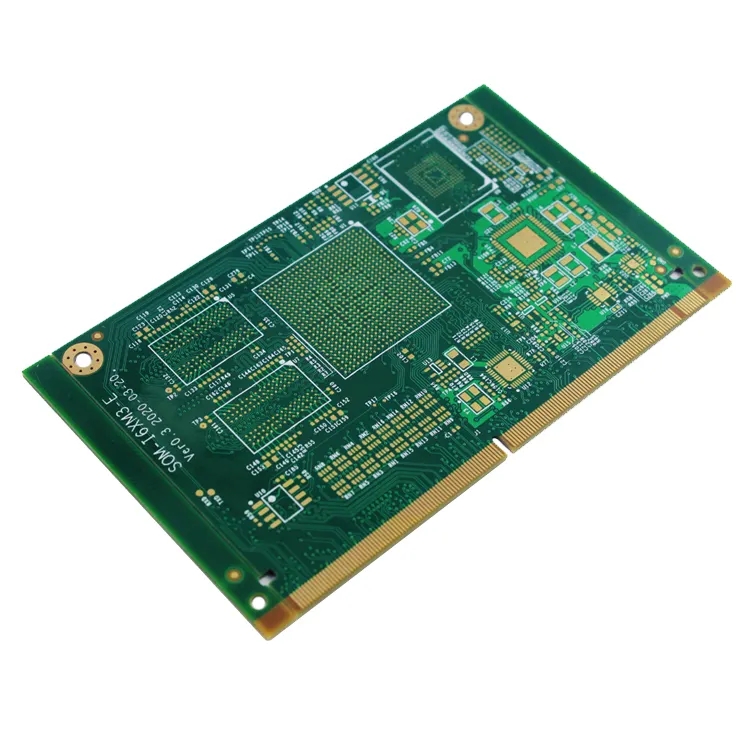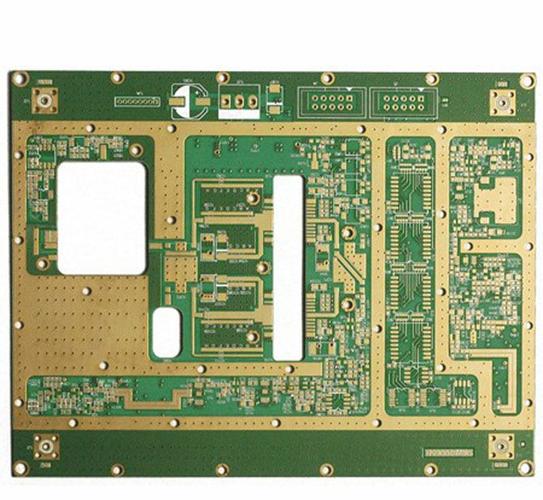
Introduction to PCB Plating Process
Electroplating process PCB can be roughly divided into acid bright copper plating, nickel/electrogold plating, and electroplating
1. Process flow:
Pickling - full plate copper plating - pattern transfer - acid degreasing - secondary countercurrent rinsing - micro etching - secondary countercurrent rinsing - pickling - tin plating - secondary countercurrent rinsing - pickling - pattern copper plating - secondary primary countercurrent rinsing - nickel plating - second stage water washing - citric acid immersion - gold plating - recycling - 2. - 3 stages pure water washing - drying
PCB board

2. Process description:
2.1 Pickling
Function and purpose: remove the surface oxides and activate the surface. The general concentration is 5%, and some are kept at about 10%, mainly to prevent water from being brought into the tank, causing unstable sulfuric acid content;
The pickling time should not be too long to prevent oxidation of the board surface; After a period of use, the acid solution should be replaced when the acid is turbid or the copper content is too high to prevent contamination of the surface of the copper plating cylinder and plate;
C. Grade P sulfuric acid shall be used here;
2.2 Copper electroplating of full PCB
1) Function and purpose: Protect the newly deposited thin chemical copper from acid attack after oxidation, and add it to a certain extent through electroplating.
2) Relevant process parameters of full plate copper plating: the main components of the plating solution are copper sulfate and sulfuric acid, and the formula of high acid and low copper is adopted to ensure that the thickness of the plate surface is evenly distributed during the electroplating process, and the deep plating capacity of deep holes and small holes is guaranteed; The content of sulfuric acid is mostly 180 g/L, mostly 240 g/L; The content of copper sulfate is generally about 75g/L. Add a small amount of chloride ion to the bath solution as an auxiliary luster agent and a copper luster agent to jointly play the luster effect; The amount of copper light agent added or opened is generally 3-5 ml/L. The addition of copper polish is generally supplemented by the method of kiloampere hour or according to the actual production board effect; The current calculation of full plate electroplating is usually 2A/square decimeter times the electroplating area of the plate. For the whole circuit board, it is the circuit board length dm à Circuit board width dm à 2à 2A/DM2; The temperature of the copper column shall be kept at room temperature, which generally does not exceed 32 ℃. The temperature is controlled at 22 ℃. In summer, it is recommended to install a cooling temperature control system for the copper cylinder because of the high temperature;
3) Process maintenance: replenish copper polish according to 1000-150ml/KAH every day; Check whether the filter pump works normally and whether there is air leakage; Wipe the cathode conductive rod with clean wet water and rag every 2-3 hours; Regularly analyze the content of copper sulfate (once/week), sulfuric acid (once/week), and chloride ion (twice/week) in the copper bottle every week, and adjust them through the Hall cell test, and timely supplement the content of light agent and related raw materials; Clean the anode conductive rod once a week, clean the electric connectors at both ends of the tank, replenish the anode copper ball in the titanium basket in time, and electrolyze for 6 to 8 hours at a low current of 0.2 to 0.5 ASD; Check whether the anode titanium basket bag is damaged every month, and replace the damaged one in time; Check whether there is anode sludge accumulation at the bottom of anode titanium basket, and clean it in time if there is; Low current electrolysis to remove impurities; Determine whether large-scale treatment (activated carbon powder) is required according to the pollution condition of tank liquid every half a year or so; The filter element of the filter pump needs to be replaced every two weeks;
4) Main processing steps: A Take out the anode, pour out the anode, clean the anode film on the anode surface, and then put it into the copper anode barrel. Roughen the copper corner surface to uniform pink with micro etchant. After drying, rinse with water, put it into the titanium basket, and put it into the acid tank for use. B. Immerse the anode titanium basket and anode bag in 10% alkali solution for 6-8 hours, rinse with water and dry them, then soak them in 5% dilute sulfuric acid, rinse with water after drying, and then use them; C. Transfer the tank liquid to the standby tank, add 1-3ml/L 30% hydrogen peroxide, and start heating. When the temperature is about 65 ℃, start air mixing, and keep air mixing for 2-4 hours; D. Turn off the air agitation, and slowly dissolve the activated carbon powder in the tank solution at the speed of 3~5g/L. After dissolution, open the air to stir and keep the temperature for 2-4 hours; E. Turn off air agitation and heat, and let the activated carbon powder slowly settle to the tank bottom; F. When the temperature drops to about 40 ℃, use 10um polypropylene filter element and filter aid powder to filter the bath solution into a clean working tank, turn on air agitation, put it into the anode, hang it on the electrolytic plate, and electrolyze for 6 to 8 hours at a low current density of 0.2-0.5ASD. G. After laboratory analysis, adjust the content of sulfuric acid, copper sulfate and chloride ion in the tank to the normal working range; According to Hall's law, when the color of the electrolytic plate is uniform, the electrolysis can be stopped, and then the electrolytic film is treated for 1-2 hours under the current density of 1-1.5ASD, and a uniform layer is formed on the anode. The dense black phosphorus film with good adhesion is sufficient; 1、 Trial plating is OK.
5) The main purpose of the anode copper ball is to reduce the anodic dissolution efficiency and reduce the generation of copper powder;
6) Supplement a large amount of copper sulfate, sulfuric acid and other drugs; After adding, electrolysis with small current; Pay attention to safety when adding sulfuric acid. When adding a large amount of sulfuric acid (more than 10 liters), slowly divide it into several times. Otherwise, the bath temperature is too high, the decomposition of the polish is accelerated, and the bath is polluted;
7) Special attention should be paid to the addition of chloride ion, because the content of chloride ion is very low (30-90ppm), and it must be accurately weighed with a measuring cylinder or measuring cup before adding; 1ml hydrochloric acid contains about 385ppm chloride ion,
2.3 Acid degreasing
1) Purpose and function: It can remove the oxide on the copper surface of the circuit and the residual glue on the ink film to ensure the adhesion between copper and electroplated copper or nickel.
2) Please remember that acid degreaser is used here. Why not use alkaline degreaser, which is superior to acid degreaser? It is mainly because the graphic ink is not alkali resistant, which will damage the graphic circuit. Only acid degreaser can be used before the graphic electroplating.
3) In the production process, only the concentration and time of degreaser need to be controlled. The degreaser concentration is about 10%, and the time is guaranteed to be 6 minutes. A little longer will have no adverse effect.
2.4 Micro etching:
1) Purpose and function: Clean and rough the copper surface of the circuit to ensure the adhesion between pattern copper and copper.
2) Sodium persulfate is mainly used as micro etchant, with stable and uniform coarsening rate and good water washability. The concentration of sodium persulfate is usually controlled at about 60 g/L and the time is controlled at about 20 seconds. The copper content per kilogram shall be controlled below 20g/l; Other maintenance and replacement cylinders were slightly corroded due to copper sinking.
2.5 Pickling
1) Function and purpose: remove the surface oxides and activate the surface. The general concentration is 5%, and some are kept at about 10%, mainly to prevent water from being brought into the tank, causing unstable sulfuric acid content;
2) The pickling time should not be too long to prevent oxidation of the board surface; After a period of use, the acid solution should be replaced when the acid is turbid or the copper content is too high to prevent contamination of the surface of the copper plating cylinder and plate;
3) C. P grade sulfuric acid shall be used here;
2.6 Pattern copper plating: also known as secondary copper plating, copper plating on the circuit
1) Purpose and function: In order to meet the rated current load of each line, each line and hole copper needs to reach a certain thickness. The purpose of line copper plating is to thicken the hole copper and hole copper to a certain thickness in time;
2) Other items are the same as the whole plate electroplating
2.7 Electrotinning
1) Purpose and function: The purpose of pattern electroplating of pure tin is to protect circuit etching by using pure tin as a metal anti-corrosion coating;
2) The bath is mainly composed of stannous sulfate, sulfuric acid and additives; The stannous sulfate content is controlled at about 35g/L, and the sulfuric acid content is controlled at about 10%; Actual production board effect; The current of tin electroplating is usually calculated by multiplying 1.5A/square decimeter by the electroplating area on the plate; The temperature of the tin cylinder is kept at room temperature, generally not more than 30 ℃, and more is controlled at 22 ℃. In summer, it is recommended to install a cooling temperature control system in the tin cylinder because of the high temperature;
3) Process maintenance: timely supplement tin plating additives according to kiloampere hours every day; Check whether the filter pump works normally and whether there is air leakage; Clean the cathode conductive rod with a clean wet cloth every 2-3 hours; The tin cylinder shall be regularly analyzed with stannous sulfate (once a week) and sulfuric acid (once a week) every week, and the content of tin plating additive shall be adjusted through Hall cell test, and relevant raw materials shall be supplemented in time; Anodes shall be cleaned once a week. Rod and electrical connector at both ends of the tank; Electrolysis with 0.2-0.5ASD low current for 6-8 hours per week; Check whether the anode bag is damaged every month, replace the damaged anode bag in time, and check whether the bottom of the anode bag is stacked. If there is anode sludge, clean it in time; Filter continuously for 6-8 hours with carbon core every month, and remove impurities with low current electrolysis; Determine whether large-scale treatment (activated carbon powder) is required according to the pollution condition of the plating solution every half a year or so; Replace the filter element of the filter pump every two weeks.
4) Large processing procedure: A Take out the anode, take down the anode bag, clean the anode surface with a copper brush, rinse with water, put it into the anode bag, and put it into the acid tank for standby B Immerse the anode bag in 10% alkali solution for 6-8 hours, rinse and dry it with water, then soak it in 5% dilute sulfuric acid, rinse and dry it with water for standby; C. Transfer the tank liquid to the standby tank, and slowly dissolve the activated carbon powder at the rate of 3-5 g/L. After the solution is completely dissolved in the bath solution, it will be adsorbed for 4-6 hours, filtered into a clean working tank with a 10um PP filter element and filter aid powder, placed in an anode, hung on the electrolytic plate, and electrolyzed at 0.2-0.5ASD current density and low current for 6-8 hours, D. After laboratory analysis, adjust the content of sulfuric acid and stannous sulfate in the tank to the normal working range; Add tin plating additive according to Hall cell test results; E. Stop electrolysis when the color of the plate surface to be electrolyzed is uniform; F. Trial plating is OK.
5) When a large amount of stannous sulfate, sulfuric acid and other drugs are supplemented; After addition, electrolysis shall be conducted under low current; Pay attention to safety when replenishing sulfuric acid. Add slowly; Otherwise, the bath temperature will be too high, the stannous oxide will be oxidized, and the aging of the bath will be accelerated.
2.8 Nickel Plating
1) Purpose and function: nickel plating layer is mainly used as a barrier layer between copper layer and gold layer to prevent mutual diffusion of gold and copper, thus affecting the weldability and service life of the plate; At the same time, the nickel layer has also greatly increased the gold layer. Mechanical strength;
2) Relevant process parameters of copper electroplating for whole plate: nickel plating additive is generally added by kiloampere hour method or according to the actual production effect of the plate, the amount of addition is about 200ml/KAH; The current calculation for pattern nickel plating is usually 2 amperes per square meter. Decimeter times the electroplating area on the plate; The temperature of the nickel cylinder shall be kept at 40-55 ° C, generally around 50 ° C. The nickel cylinder shall be equipped with heating and temperature control system;
3) Process maintenance: timely supplement nickel plating additives according to kiloampere hours every day; Check whether the filter pump works normally and whether there is air leakage; Clean the cathode conductive rod with a clean wet cloth every 2-3 hours; The contents of nickel sulfate (nickel sulfamate) (once/week), nickel chloride (once/week), and boric acid (once/week) in copper bottles should be analyzed regularly 2-3 hours a week, and Hall cell tests should be conducted to adjust the content of nickel plating additives, and relevant raw materials should be supplemented in a timely manner; Clean the anode conductive rod and electric connectors at both ends of the tank every week, supplement the anode nickel angle in the titanium basket in time, and electrolyze for 6-8 hours with 0.2~0.5ASD low current; Check whether the anode titanium basket bag is damaged every month, and replace it if damaged; Check whether there is anode sludge accumulation at the bottom of anode titanium basket, and clean it in time if there is; Removal of impurities by current electrolysis; Determine whether large-scale treatment (activated carbon powder) is required according to the pollution condition of tank liquid every half a year or so; The filter element of filter pump shall be replaced every two weeks;
4) Main processing steps: A Take out the anode, pour out the anode, clean the anode, and then put the nickel corner into a barrel to package it. Roughen the nickel corner surface to uniform pink with micro etchant. After cleaning and drying, put it into the titanium basket and put it into the acid tank for use. B. Immerse the anode titanium basket and anode bag in 10% alkali solution for 6 to 8 hours, rinse with water, and then soak with 5% dilute sulfuric acid; C. Transfer the tank liquid to the standby tank, add 1-3ml/L 30% hydrogen peroxide, and start heating. When the temperature is about 65 ℃, start air mixing, and keep air mixing for 2-4 hours; D. Turn off the air agitation, and slowly dissolve the activated carbon powder into the tank solution at the speed of 3~5g/L. After dissolution, open the air to stir and keep it for 24 hours; E. Turn off the air agitation, heat, and let the activated carbon powder slowly settle to the tank bottom; F. When the temperature drops to about 40 ℃, use 10um PP filter element and filter powder to filter the bath solution into a clean working tank, turn on air agitation, place the anode, and hang it on the electrolytic plate. Electrolyte for 6 to 8 hours at low current according to 0.2-0.5ASD current density, G. After laboratory analysis, adjust nickel sulfate or nickel sulfamate, and the content of nickel chloride and boric acid in the tank reaches the normal working range; Huo said that the battery test results added nickel plating additives; H. When the color of the electrolytic plate is uniform, the electrolysis can be stopped, and then the anode can be started for 10-20 minutes by electrolytic treatment under the current density of 1-1.5ASD; 1、 Trial plating is OK. You can;
5) When supplementing drugs such as nickel sulfate or nickel sulfamate, nickel chloride should be electrolyzed with low current after addition; When adding boric acid, put the added amount of boric acid into a clean anode bag and hang it. It can be put into the nickel cylinder instead of directly into the tank;
6) After nickel plating, it is recommended to add recycle water for cleaning, open the cylinder with pure water, which can be used to replenish the liquid level volatilized from the nickel cylinder due to heating, and then conduct secondary countercurrent flushing after the recycle water is cleaned;
The above is the explanation given by the editor of pcb circuit board company. If you want to know more about PCBA, you can go to our company's home page to learn about it. In addition, our company also sells various circuit boards,
High frequency circuit board and SMT chip are waiting for your presence again.







